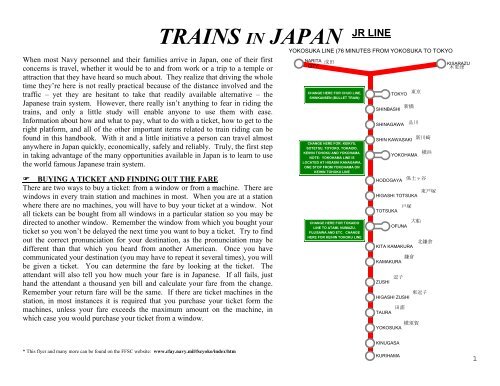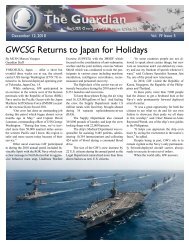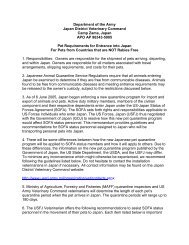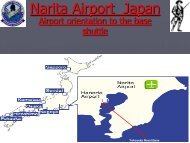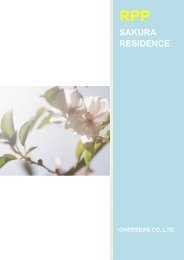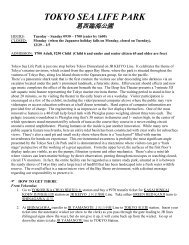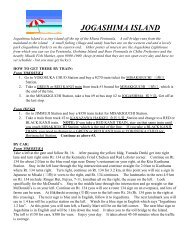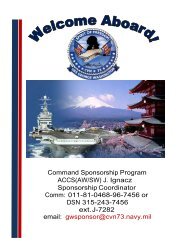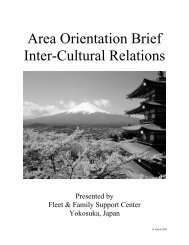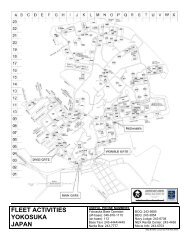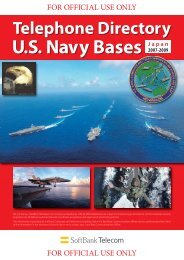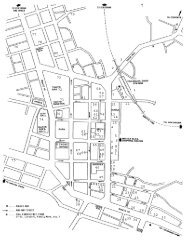TRAINS IN JAPAN
TRAINS IN JAPAN
TRAINS IN JAPAN
Create successful ePaper yourself
Turn your PDF publications into a flip-book with our unique Google optimized e-Paper software.
When most Navy personnel and their families arrive in Japan, one of their first<br />
concerns is travel, whether it would be to and from work or a trip to a temple or<br />
attraction that they have heard so much about. They realize that driving the whole<br />
time they’re here is not really practical because of the distance involved and the<br />
traffic – yet they are hesitant to take that readily available alternative – the<br />
Japanese train system. However, there really isn’t anything to fear in riding the<br />
trains, and only a little study will enable anyone to use them with ease.<br />
Information about how and what to pay, what to do with a ticket, how to get to the<br />
right platform, and all of the other important items related to train riding can be<br />
found in this handbook. With it and a little initiative a person can travel almost<br />
anywhere in Japan quickly, economically, safely and reliably. Truly, the first step<br />
in taking advantage of the many opportunities available in Japan is to learn to use<br />
the world famous Japanese train system.<br />
BUY<strong>IN</strong>G A TICKET AND F<strong>IN</strong>D<strong>IN</strong>G OUT THE FARE<br />
There are two ways to buy a ticket: from a window or from a machine. There are<br />
windows in every train station and machines in most. When you are at a station<br />
where there are no machines, you will have to buy your ticket at a window. Not<br />
all tickets can be bought from all windows in a particular station so you may be<br />
directed to another window. Remember the window from which you bought your<br />
ticket so you won’t be delayed the next time you want to buy a ticket. Try to find<br />
out the correct pronunciation for your destination, as the pronunciation may be<br />
different than that which you heard from another American. Once you have<br />
communicated your destination (you may have to repeat it several times), you will<br />
be given a ticket. You can determine the fare by looking at the ticket. The<br />
attendant will also tell you how much your fare is in Japanese. If all fails, just<br />
hand the attendant a thousand yen bill and calculate your fare from the change.<br />
Remember your return fare will be the same. If there are ticket machines in the<br />
station, in most instances it is required that you purchase your ticket form the<br />
machines, unless your fare exceeds the maximum amount on the machine, in<br />
which case you would purchase your ticket from a window.<br />
<strong>TRA<strong>IN</strong>S</strong> <strong>IN</strong> <strong>JAPAN</strong><br />
JR L<strong>IN</strong>E<br />
YOKOSUKA L<strong>IN</strong>E (76 M<strong>IN</strong>UTES FROM YOKOSUKA TO TOKYO<br />
NARITA<br />
CITY<br />
成 田<br />
CHANGE HERE FOR CHUO L<strong>IN</strong>E,<br />
SH<strong>IN</strong>KANSEN (BULLET TRA<strong>IN</strong>)<br />
CHANGE HERE FOR: KEIKYU,<br />
SOTETSU, TOYOKO, TOKAIDO,<br />
KEIH<strong>IN</strong> TOHOKU AND YOKOHAMA.<br />
NOTE: YOKOHAMA L<strong>IN</strong>E IS<br />
LOCATED AT HIGASHI KANAGAWA,<br />
ONE STOP FROM YOKOHAMA ON<br />
KEIH<strong>IN</strong> TOHOKU L<strong>IN</strong>E<br />
CHANGE HERE FOR TOKAIDO<br />
L<strong>IN</strong>E TO ATAMI, NUMAZU,<br />
FUJISAWA AND ETC. CHANGE<br />
HERE FOR KEIH<strong>IN</strong> TOHOKU L<strong>IN</strong>E<br />
SH<strong>IN</strong>BASHI<br />
SH<strong>IN</strong>AGAWA<br />
SH<strong>IN</strong> KAWASAKI<br />
HODOGAYA<br />
HIGASHI TOTSUKA<br />
TOTSUKA<br />
KITA KAMAKURA<br />
鎌 倉<br />
KAMAKURA<br />
ZUSHI<br />
東 逗 子<br />
HIGASHI ZUSHI<br />
TAURA<br />
TOKYO<br />
YOKOHAMA<br />
OFUNA<br />
逗 子<br />
田 浦<br />
新 橋<br />
保 土 ヶ 谷<br />
戸 塚<br />
東 京<br />
品 川<br />
大 船<br />
横 須 賀<br />
YOKOSUKA<br />
新 川 崎<br />
横 浜<br />
東 戸 塚<br />
北 鎌 倉<br />
KISARAZU<br />
木 更 津<br />
* This flyer and many more can be found on the FFSC website: www.cfay.navy.mil/fscyoko/index/htm<br />
K<strong>IN</strong>UGASA<br />
KURIHAMA<br />
1
Yokohama Station<br />
In many stations there are bilingual machines that accept 10,000-yen bills, and when the<br />
machines are present customers are expected to utilize them. When using a ticket<br />
machine you will have to determine the fare to your destination. Your destination and<br />
your fare will be posted on a map usually located on the wall above or near the ticket<br />
machine. If you know the KANJI for your destination, or have it written down on a piece<br />
of paper, just look on that map for your destination’s fare. If you still can’t figure out<br />
your fare, buy the cheapest ticket that is available. It is not difficult especially since most<br />
train stations have gone to bilingual train maps. However some of the smaller stations<br />
you may encounter may not be entirely bilingual and will only have the major train<br />
stations in English if any at all. That is why we highly recommend that you get your<br />
destination written in KANJI before you travel. In stations serving more than one train<br />
line, there may be several different types of ticket machines. To make it easier for you to<br />
distinguish between the different machines that serve the different train lines, please refer<br />
to the following list of the KANJI characters for several train lines in the local area.<br />
TO SHOPP<strong>IN</strong>G AREA<br />
TO SOTETSU L<strong>IN</strong>E<br />
相 鉄 線<br />
WEST EXIT<br />
西 口<br />
ENTRANCE FOR TOYOKO L<strong>IN</strong>E<br />
TRANSFER FOR<br />
JR/TOYOKO<br />
東 横 線<br />
<strong>JAPAN</strong> RAILWAYS (JR)<br />
JR 線<br />
KEIH<strong>IN</strong> KYUKO L<strong>IN</strong>E (KEIKYU OR KHK) 京 浜 急 行 線 ( 京 急 線 )<br />
TOYOKO L<strong>IN</strong>E<br />
東 横 線<br />
SAGAMI TESDO L<strong>IN</strong>E (SOTETSU L<strong>IN</strong>E) 相 模 鉄 道 線 ( 相 鉄 線 )<br />
CENTRAL PASSAGEWAY<br />
The following trains are all a part of Japan Railways (JR) system in the Tokyo area:<br />
Yokosuka Line 横 須 賀 線 Chuo Line 中 央 線<br />
Keihin Tohoku Line 京 浜 東 北 線 Sobu Line 総 武 線<br />
Tokaido Line 東 海 道 線 Nambu Line 南 武 線<br />
Yamanote Line 山 手 線<br />
When transferring among these lines, you don’t need to purchase different tickets,<br />
for they are all part of one big system. However, when transferring to other<br />
commercial train lines it is necessary to buy a new ticket when you leave one line<br />
and go to another.<br />
LUM<strong>IN</strong>E<br />
EAST EXIT<br />
東 口<br />
KEIKYU<br />
TICKET MACH<strong>IN</strong>E<br />
TRANSFER FOR<br />
KEIKYU/JR<br />
ENTRANCE FOR<br />
KEIKYU<br />
NOTE: You do not buy tickets that will take you to a particular destination. You<br />
buy a ticket for the amount of the fare that it takes to get you there.<br />
2
Keikyu Train Map<br />
3<br />
MISAKIGUCHI<br />
MABORI馬 堀 海 岸<br />
KAIGAN<br />
KEIKYU OTSU<br />
HOR<strong>IN</strong>OUCHI<br />
KEIKYU YASURA<br />
YOKOSUKA CHUO<br />
SHIOIRI<br />
HEMI<br />
KEIKYU TAURA<br />
SH<strong>IN</strong>ZUSHI<br />
ANJ<strong>IN</strong>ZUKA<br />
JIMMUJI<br />
OPPAMA<br />
MUTSUURA<br />
KANAZAWA<br />
HAKKEI<br />
KANAZAWA<br />
BUNKO<br />
NOKENDAI<br />
KEIKYU<br />
TOMIOKA<br />
SUGITA<br />
BYOBU<br />
GA URA<br />
KAMIOOKA<br />
GUMYOJI<br />
IDOGAYA<br />
M<strong>IN</strong>AMI OTA<br />
KOGANE-CHO<br />
H<strong>IN</strong>ODE-CHO<br />
浦 賀<br />
URAGA<br />
YOKOHAMA<br />
SUBWAY<br />
三 崎 口<br />
戸 部<br />
TOBE<br />
YOKOHAMA<br />
横 浜<br />
神 奈 川<br />
KANAGAWA<br />
NAKAKIDO<br />
仲 木 戸<br />
KANAGAWA<br />
SH<strong>IN</strong>MACHI<br />
神 奈 川 新 町<br />
三 浦 海 岸 MIURA KAIGAN<br />
津 久 井 浜 TSUKUIHAMA<br />
京 急 長 沢 KEIKYU NAGASAWA<br />
YRP 野 比 YRP NOBI<br />
京 急 久 里 浜 KEIKYU KUKRIHAMA<br />
北 久 里 浜 KITA KURIHAMA<br />
新 大 津 SH<strong>IN</strong> OTSU<br />
KOYASU<br />
京 急 大 津<br />
子 安<br />
KEIKYU<br />
京 急 新 子 安<br />
SH<strong>IN</strong> KOYASU<br />
KOJIMA<br />
SH<strong>IN</strong>DEN<br />
小 島 新 田<br />
堀 ノ 内<br />
生 麦<br />
NAMAMUGI<br />
SANGYO-DORO<br />
産 業 道 路<br />
京 急 安 浦<br />
花 月 園 前<br />
KAGETSU-EN<br />
MAE<br />
HIGASHI-MON<br />
MAE 東 門 前<br />
横 須 賀 中 央<br />
京 急 鶴 見<br />
KEIKYU<br />
TSURUMI<br />
KAWASAKI<br />
DAISHI<br />
汐 入<br />
鶴 見 市 場<br />
TSURUMI<br />
ICHIBA<br />
川 崎 大 師<br />
SUZUKI-CHO<br />
鈴 木 町<br />
逸 見<br />
八 丁 畷<br />
NATCHO<br />
NAWATE<br />
M<strong>IN</strong>ATO-CHO<br />
港 町<br />
京 急 田 浦<br />
新 逗 子<br />
京 急 川 崎<br />
KEIKYU<br />
KAWASAKI<br />
安 針 塚<br />
神 武 寺<br />
六 郷 土 手<br />
ROKUGO DOTE<br />
追 浜<br />
六 浦<br />
雑 色<br />
ZOSHIKI<br />
金 沢 八 景<br />
京 急 蒲 田<br />
KEIKYU<br />
KAMATA<br />
金 沢 文 庫<br />
梅 屋 敷<br />
UME YASHIKI<br />
KOJIYA<br />
糀 谷<br />
能 見 台<br />
大 森 町<br />
平 和 島<br />
大 森 海 岸<br />
OMORI-CHO<br />
HEIWAJIMA<br />
OMORI<br />
KAIGAN<br />
立 会 川 TACHIAIGAWA<br />
鮫 州<br />
SAMEZU<br />
OTORII<br />
ANAMORI-<br />
<strong>IN</strong>ARI<br />
大 鳥 居<br />
TENKU-BASHI<br />
HANEDA<br />
AIRPORT<br />
穴 守 稲 荷<br />
天 空 橋<br />
成 田 空 港<br />
京 急 富 岡<br />
上 大 岡<br />
杉 田<br />
屏 風 浦<br />
青 物 横 丁<br />
新 馬 場<br />
AOMONO<br />
YOKOCHO<br />
SHIMBAMBA<br />
北 品 川 KITASH<strong>IN</strong>AGAWA<br />
品 川<br />
泉 岳 寺<br />
SH<strong>IN</strong>AGAWA<br />
SENGAKUJI<br />
弘 明 寺<br />
井 土 ヶ 谷<br />
南 太 田<br />
黄 金 町<br />
日 ノ 出 町<br />
BLACK KANJI (LOCAL) TRA<strong>IN</strong><br />
RED KANJI (EXPRESS) TRA<strong>IN</strong><br />
GREEN KANJI (RAPID EXPRESS) TRA<strong>IN</strong>
TICKET MACH<strong>IN</strong>E<br />
There are several types of ticket machines. One type is a single price machine<br />
which dispenses only one particular price tickets. They are usually found in<br />
subway stations. If the machine has a big 100-yen sign at the top, that machine<br />
will only sell 100 yen tickets. At most stations, there are several machines of this<br />
type each dispensing tickets of one particular price in that varying amount of the<br />
available fares.<br />
Most ticket machines in Yokosuka are capable of dispensing transfer tickets.<br />
They have buttons for each place/line that you can transfer to a certain station. At<br />
Keikyu stations, the color of the transfer button is the same color as the train line<br />
on the train map. Once you find your station on the map, press the same color<br />
transfer button and press the fare button. When you choose one for transfer, each<br />
price will come up on the price button. JR station has a bilingual ticket machineyou<br />
press the English button on the menu displayed.<br />
F<strong>IN</strong>D<strong>IN</strong>G THE RIGHT TRACK AND TRA<strong>IN</strong><br />
Now that you have bought your ticket, you are ready to go through the wicket.<br />
Insert the ticket in the wicket and pick it up at the other side of the wicket. You<br />
must keep your ticket till you go through the wicket at your destination. You can<br />
find the entrance by following someone else who has just purchased a ticket.<br />
Fortunately, most train stations in Tokyo & Yokohama have English signs for<br />
platforms, lines and directions. Since only the main stations are mentioned on the<br />
signs it’s a good idea to know the major stops in the directions. It is also good to<br />
know the color of the train that you would like to take. The easiest way to find<br />
out the right track and train is to take your ticket to a person working at the station<br />
and ask him for directions. (Use one of the useful expressions provided)<br />
FARE ADJUSTMENT<br />
If you buy the wrong ticket or decide to get off at a different stop, don’t panic!<br />
Just look for the fare adjustment window or office. These are often marked in<br />
English. They are usually located next to the exits. Just hand the person your<br />
ticket and he will tell or show you how much you owe. Pay him the money and<br />
he will give you a receipt. You may now exit the station. Remember, all tickets<br />
have a date on them, and are only valid for the purchase day. Also if you buy a<br />
ticket for more than what you needed, you will not get a refund, so consider it a<br />
donation to the train company. When in doubt, buy the cheapest ticket and adjust<br />
the fare when you get off to your destination.<br />
乗 車 券<br />
Cancel<br />
Ticket Type<br />
JR Ticket<br />
Ticket<br />
連 絡 会 社 線 Transfer Ticket<br />
回 数 券 Multiple Trip Ticket<br />
往 復 券 Round ticket<br />
グリーン 券 Green Car Ticket<br />
グリーン 回 数 券 Green Car Multiple Ticket<br />
トクトクきっぷ Discount Ticket<br />
English<br />
Button<br />
Transfer<br />
Ticket<br />
Multiple-<br />
Trip<br />
Ticket<br />
Round<br />
Ticket<br />
Green Car<br />
Ticket<br />
Green Car<br />
Multiple-<br />
Trip Ticket<br />
Discount<br />
Ticket<br />
4
PLATFORM TICKETS<br />
Most stations permit people to purchase platform tickets for the purpose of<br />
meeting people or seeing off someone. Platform Tickets are called “Nyujo-<br />
Ken”, and can be purchased from some ticket machines or from a window.<br />
These tickets permit you to go right up to the platform where the trains are.<br />
But you are not permitted to board any train with this ticket. If you decide<br />
to get on the train, you must exit the platform and purchase a regular ticket.<br />
KEIKYU TICKET MACH<strong>IN</strong>E<br />
TRA<strong>IN</strong> PASSES<br />
If you commute regularly between two stations, it may be less expensive if<br />
you buy a train pass (“Teiki-Ken”) instead of paying for a ticket each trip.<br />
Train passes can only be used for trips between the stations indicated on the<br />
pass and for trips to and from any stations in between. If you want to go<br />
further than the station indicated on your pass, you can use the pass when<br />
getting on the train and when you reach your destination, go to the fare<br />
adjustment and the clerk will calculate your fare from the station indicated<br />
on your pass and your current location. If you use the train on a daily basis,<br />
you can save as much as 30% by purchasing a train pass. Train passes may<br />
be purchased for periods of one, three or six months. Remember, train<br />
passes can only be used by the person whose name appears on the pass. To<br />
purchase a train pass, locate the special window at the station designated for<br />
passes and complete an application form. This form should be available<br />
either in front of the window or on a table near the window. The form is not<br />
in English; however, if you state the station that you travel to and from, and<br />
the length of time that you need the pass, the clerk will probably be able to<br />
assist you. To be on the safe side, it would be wise to have a Japanese<br />
friend help you fill out the form ahead of time.<br />
Prepaid Card<br />
Cancel<br />
Keikyu<br />
Call Attendant<br />
Toei Asakusa<br />
Transfer<br />
for bills<br />
Keisei Line<br />
Transfer<br />
Tokyu Line<br />
Transfer<br />
2 3<br />
Sotetsu Line<br />
Transfer<br />
JR Transfer at Yokohama<br />
for coins<br />
When you buy<br />
more than 1<br />
ticket.<br />
Child Button<br />
JR Transfer at<br />
Shinagawa<br />
Keihin Kyuko<br />
(Keikyu) to<br />
Haneda Ariport<br />
COMMUTER TICKET PACKAGE<br />
If you use the train on a regular but not daily basis it is still possible to save<br />
money by purchasing a Commuter Ticket Package or “Kaisu-Ken”. A<br />
Commuter Ticket Package is sold with 11 tickets in it for the price of 10<br />
tickets, these are good between two particular stations and are good for two<br />
months.<br />
Ticket and<br />
Change will come<br />
out<br />
5
GREEN CAR<br />
Most long distance JR trains have what is known as a “Green Car”.<br />
This car is more luxurious and comfortable than ordinary cars and can<br />
be identified by a green stripe down the side of the car and a clover<br />
design with “Green Car” written beneath it. Inside, it has reclining<br />
seats with white seat covers and there is more space for the passengers.<br />
Traveling in a Green Car requires an additional ticket and the fare<br />
increases as the distance traveled increases and can be quite expensive.<br />
Tickets for the Green Car may be purchased either at the ticket window<br />
in the station or from the conductor who walks through the Green Car<br />
to assist travelers. Be aware that purchasing a Green Car ticket will not<br />
always guarantee you a seat and you must have a ticket to even stand in<br />
the Green Car. During the morning and afternoon rush hours, you<br />
cannot move freely from the regular cars into the Green Car, since<br />
those who have Green Car passes are given precedence during this time.<br />
At other times, however, you may move from the regular cars into the<br />
Green Car provided of course, that you pay the additional fare to the<br />
conductor when he comes around. In the local area, only the Yokosuka<br />
Line has Green Cars.<br />
EXPRESS <strong>TRA<strong>IN</strong>S</strong><br />
If you board the correct train but it passes your station without stopping,<br />
you are probably on an express train. The characters for various types<br />
of express trains are located in the phrase/character section of this<br />
manual. Please learn the word for express and find out if the line you<br />
are on has express service trains. If so, check the timetables around the<br />
platform for the scheduled times of the express trains. Also, the front,<br />
rear and sometimes side information windows on the cars of express<br />
trains will have some sort of green or red coloring (green or red Kanji)<br />
on a white background or white Kanji on a green or red background).<br />
The only line serving Yokosuka that has express service is Keihin<br />
Kyuko Line (Keikyu/KHK). Two other lines, which serve Yokohama<br />
and have express services, are the Sagami Tetsudo and Toyoko Lines.<br />
TERM<strong>IN</strong>AT<strong>IN</strong>G <strong>TRA<strong>IN</strong>S</strong><br />
Another problem that might be encountered is a train that stops before<br />
reaching the last stop on the line. In this case everyone on board will<br />
get off the train and either board another train on the other side of the<br />
platform, or wait for another train to come along. Trains that stop like<br />
this in mid-route can be identified by a notation on the timetable (this is<br />
usually located somewhere on the platform) or by reading the<br />
destination on the front, side or back of train.<br />
On some lines the last train of the day does not run the whole length of<br />
the line and when it stops at an intermediate station there won’t be any<br />
more trains. For example, the last train on Yokosuka Line from Tokyo<br />
station goes only as far as Zushi. So if you wish to take the last train<br />
back to Yokosuka from Tokyo, you must take the next to last train that<br />
departs Tokyo. All train lines stop running at approximately midnight<br />
and resume services at approximately 0500.<br />
RESERVATIONS, RESERVED SEATS AND SLEEPERS<br />
The best way to get a reservation is to visit JTB (Japan Travel Bureau)<br />
and let them arrange the transportation for you. Normally, reserved<br />
seats go on sale seven days prior to the date of departure of the train,<br />
but there are some tickets available for reservations as far as three<br />
weeks ahead. If you want to make your own reservations you must go<br />
to one of JR stations that has what is called a green window (Midori no<br />
Madoguchi). There is one at JR Yokosuka station. You need to fill<br />
out an application that gives the time, day and number of seats<br />
required at the window. In most cases the attendants will help<br />
foreigners fill out the papers provided that the foreigner knows which<br />
train that they want to take. There’s no obligation for the attendants to<br />
do this. Once again it would be beneficial to have a Japanese friend<br />
help you. Different trains have different numbers of reserved seats.<br />
The Bullet Train is composed almost entirely of reserved seats,<br />
although there are some cars on every train that have seats available<br />
(Jiyu-seki) where it’s first come, first served. Most other long distance<br />
trains have at least some reserved seats. Tickets for long distance JR<br />
trains may be purchased at the Green Window, but for long distance<br />
seats on private lines it is necessary to go to the station where the train<br />
originates to obtain the ticket.<br />
6
From Tokyo to southern and northern areas of Japan there are trains<br />
with sleeper cars. These come in two different classes, first and<br />
second. The first-class sleepers consist of small (by our standards)<br />
comfortable bunks, three high; second-class sleepers have two sets of<br />
three high. These bunks are put up in the morning and made into seats<br />
for daytime travel. The tickets are obtained in the same way as<br />
reserved seats. Generally the total cost of a train ride including sleeper<br />
will be somewhat less than airfare for the same distance.<br />
RUSH HOUR<br />
If you ride the trains toward Tokyo in the early morning or away from<br />
Tokyo in the evening, be prepared for large crowds. Like<br />
transportation systems anywhere, during these hours there are many<br />
more people trying to use the trains than they were designed to<br />
accommodate. If you travel at these times, relax and follow the crowd.<br />
Since the trains and platforms tend to be crowded during these times<br />
travelers tend to push their way around in order to make their next stop.<br />
It is helpful to remember that in most cases it is least crowded in the<br />
very front and rear of the trains and is worse in the middle. Once you<br />
get on the train, try to get away from the doors if you are planning to<br />
ride the train for a while, otherwise you might be pushed out at the<br />
next stop by the crowd getting off the train. If you find yourself in this<br />
position, don’t try to stand still, it won’t work. Just get off with the<br />
crowd and then get back on the train. Of course the best way to ride<br />
the trains is to have a seat, and since Yokosuka is near the end of the<br />
line, it’s usually possible to find one. If you are using JR Line,<br />
sometimes 4 cars are added to Tokyo bound trains at Zushi, so if you<br />
don’t get a seat in Yokosuka, get towards the back of train and you<br />
should be able to get one at Zushi. If you are in Tokyo and are<br />
planning to come home during the rush hour it will normally be to<br />
your advantage to leave from Tokyo station rather than Shimbashi or<br />
Shinagawa (if you are using JR Yokosuka Line), because Tokyo is<br />
closer to the end of the line and it will be easier to get a seat.<br />
STRIKE<br />
About twice a year (usually fall and spring), the railroads may have a<br />
strike or a slowdown. Strikes usually last only two days, while<br />
slowdowns could go on for several days. These dates will normally be<br />
published in the newspapers ahead of time so you should try to find out<br />
these dates and avoid the trains on these days. During slowdowns there<br />
are fewer trains and they take longer than usual to reach their<br />
destinations, sometimes stopping for minutes at a time for no apparent<br />
reason. This can be quite annoying and frustrating if you are in a hurry.<br />
The only other time that trains may slowdown is if there’s an accident<br />
further up the line. If you are on a train that is behaving this way, you<br />
are probably experiencing one of these situations. There’s absolutely<br />
nothing you can do in this situation except grin and bear it.<br />
CHILDREN’S FARES<br />
Children over 12 years old pay the adult fare. Children between the<br />
ages of 6 – 12 yrs travel at half price. Children under the age of 6<br />
travel for free as long as no more than two are traveling with a single<br />
adult. In cases where there are more than two such children with an<br />
adult, each child must have a child’s ticket (six to twelve ticket).<br />
DETAILED <strong>IN</strong>FORMATION ON SEVERAL HIGHLY USED<br />
TRA<strong>IN</strong> L<strong>IN</strong>ES<br />
BASIC COLORS OF SOME TOKYO AREA L<strong>IN</strong>ES<br />
YOKOSUKA L<strong>IN</strong>E<br />
Royal Blue and Cream<br />
KEIH<strong>IN</strong> KYUKO L<strong>IN</strong>E<br />
Red with narrow white<br />
stripes<br />
KEIH<strong>IN</strong> TOHOKU L<strong>IN</strong>E Light blue<br />
TOYOKO L<strong>IN</strong>E<br />
Silver<br />
SAGAMI TETSUDO L<strong>IN</strong>E Light Green, Silver with a<br />
Red stripe and Yellow<br />
YAMANOTE L<strong>IN</strong>E<br />
Light Green<br />
TOKAIDO L<strong>IN</strong>E<br />
Green and Orange<br />
YOKOHAMA L<strong>IN</strong>E<br />
Brown<br />
ENOSHIMA L<strong>IN</strong>E<br />
Forest Green and White<br />
7
1. KEIH<strong>IN</strong> KUKO L<strong>IN</strong>E (KEIKYU/KHK)<br />
This privately owned line is the fastest between Yokosuka and Tokyo,<br />
but is a little more complicated than using JR Yokosuka Line. You<br />
should take a little time to learn how this line operates. Keikyu Line has<br />
a variety of express and local services. It not only connects<br />
Yokosuka/Kurihama to Tokyo but also has several branch lines, one of<br />
which serves Zushi City where Ikego housing is located. Keikyu<br />
stations are much closer together and far more numerous than those on<br />
JR systems. In some places, Keikyu Line serves the same places as JR<br />
serves, but doesn’t necessarily use the same stations. A good example is<br />
Yokosuka, which is served by both Keikyu and JR Yokosuka Line.<br />
These lines use entirely different stations, which are about one-half mile<br />
apart. In fact, Keikyu Line has two stations in the downtown Yokosuka<br />
area: Yokosuka Chuo Station and Shioiri Station. Another example is<br />
Kawasaki, which is served by both lines. Keikyu line doesn’t use<br />
Kawasaki station but Keikyu Kawasaki station, about one-quarter mile<br />
away. When Keikyu (or any other private line for that matter) does<br />
share a station with other lines, its facilities will be separate. Yokohama<br />
station is a good example of this. Both Keikyu and JR lines as well as<br />
other lines use Yokohama station.<br />
Keikyu uses tracks 1 and 2, JR uses 3 through 10 and the other private<br />
line: Sagami Tetsudo and Toyoko line use 11 and above. Although<br />
Keikyu line is adjacent to JR line, access to Keikyu line is through a<br />
separate set of wickets. If you wish to transfer to Keikyu line from JR<br />
line at Yokohama, you must turn in your JR ticket at the exit wicket and<br />
purchase a new ticket from Keikyu ticket machine.<br />
When transferring from Keikyu line to a JR line, the situation is<br />
somewhat different at Yokohama station. When going out certain exits,<br />
you will have to keep your ticket, only showing it to the ticket taker.<br />
The reason for this is that certain exits from Keihin Kyuko Line area<br />
allow passengers to pass directly into the inside of Yokohama station.<br />
All the ticket taker is going to do is look at your ticket and make sure it<br />
is good as far as Yokohama. Then if you get on a JR line without a<br />
cross-line ticket, you will simply pay the remaining of the fare at your<br />
destination. If you just go out one of the main exits of the station, then<br />
you will go through another gate and the ticket taker will then take your<br />
ticket. If this is confusing you, don’t worry; it confuses most Japanese<br />
as well. Yokohama is one of the most confusing train stations in that<br />
respect. Most other stations where private and public lines coexist have<br />
totally separate facilities and you must exit from the one line before you<br />
get on the next one. As it was mentioned, Keikyu line has several<br />
different types of trains. The way to tell the different types of local and<br />
express trains on this line is by the different types of KANJI characters<br />
on the front and sides of the train cars. These KANJI characters are<br />
located inside little windows placed above the middle set of doors on the<br />
train cars and on the front of the first train car. Fortunately, these<br />
characters are color coded, so one can identify the train type without<br />
having to know how to read KANJI. Remember, the actual color of the<br />
train itself is RED. This never changes. What does change though, is<br />
the color of the KANJI windows, which identifies the train as a local,<br />
express, rapid express. The three train types along with their Japanese<br />
names and their KANJI character colors are as follows:<br />
Local Futsu Black KANJI characters<br />
Limited Express Tokkyu Red KANJI characters<br />
Rapid Express Kaisoku Green KANJI characters<br />
When the little windows on the sides of the train cars have no KANJI in<br />
them this indicates a local train. From fastest to slowest, or from least to<br />
most number of stops, the KANJI character color is what identifies the<br />
type of the train whether it’s green, red or black. The timetable posted at<br />
several points at the station also indicates the type of trains on Keikyu<br />
Line. If the number is printed in red, for example, then the train leaving<br />
at the time is a limited express train. This follows for all of the different<br />
colors as well. Some hints for using the Keikyu Line:<br />
The front of the train has KANJI indicating the destination for that train,<br />
so you can check this against the list of cities provided in this handout.<br />
The northbound trains usually have one of two destinations: either<br />
Shinagawa (a major station on JR Yamanote Line) or Oshiage. Those<br />
that continue on past Shinagawa to Oshiage do go underground as part<br />
of Toei Asakusa Line. When in Shinagawa and returning to Yokosuka<br />
keep in mind that they have a direct line that goes to Haneda Airport<br />
from Shinagawa on Rapid Express (Green Kanji) & Express (Red Kanji).<br />
These trains have an airplane picture in the window as well, and don’t<br />
go back towards Yokosuka. You need to take a Rapid Express (Green<br />
8
Kanji without an airplane picture) to come back to Yokosuka Chuo.<br />
Note: Express trains (Red Kanji) don’t run during the daytime.<br />
2. JR YOKOSUKA L<strong>IN</strong>E<br />
Most military personnel in Yokosuka area have their first experience<br />
with Japanese trains on JR Yokosuka Line of JR system. This line with<br />
its cream and royal blue colored cars run from Kurihama in the south to<br />
Tokyo Station and beyond Chiba, Narita and Kisarazu. They have stops<br />
in such places as Zushi, Kamakura, Ofuna, Totsuka Yokohama and<br />
Shinagawa as well as others (Map on page 1). JR Yokosuka Line is one<br />
of the easiest lines to use. There are fewer originating terminating stops<br />
than on other lines and many of the signs in the stations are in English.<br />
In addition, all trains on this line stop at all stations along the way, so<br />
there are no express trains. It is on JR Yokosuka Line that you will find<br />
the special cars known as Green Cars. Please see Page 6 for details on<br />
these. One thing occurs on JR Yokosuka Line that is unusual. At Zushi<br />
station, four cars may be added to or removed from the train.<br />
Southbound trains often have their four forward most cars removed<br />
because the stations beyond cannot accommodate the extra length. For<br />
northbound trains the process is reversed and the four cars are added for<br />
the remainder of the trip. Therefore, if everyone else is getting off at<br />
Zushi, follow them to one of the rear cars and get on the train again for<br />
Yokosuka. Or, when going north, stand near the rear of the train and<br />
you have a good chance of getting a seat when they add the four extra<br />
train cars at Zushi.<br />
Also usually, during non-rush hours, trains leaving Yokosuka station<br />
will terminate at Zushi and you will have to change trains to continue<br />
north. The same thing happens coming back towards Yokosuka (south),<br />
you have to change trains at Zushi for another train to return to<br />
Yokosuka. The information window on the sides of the train cars will<br />
tell you the final destination of the train.<br />
3. JR YAMANOTE L<strong>IN</strong>E<br />
This line is famous for its distinctive construction: it runs in a large<br />
circle around the main downtown area of Tokyo. One can get on at any<br />
point and in about an hour and twenty minutes arrive back at the same<br />
place they started. Due to its location, JR Yamanote Line is the main<br />
train line in Tokyo. It carries more passengers than any other line and<br />
serves almost Tokyo’s entire principal downtown subways. From its<br />
various stations branch off most of Tokyo’s suburban lines and<br />
downtown subways. Some of the larger stations on JR Yamanote Line<br />
serve many important areas.<br />
You can pick up JR Yamanote Line at Shinagawa station by transferring<br />
from either JR Yokosuka Line or Keikyu Line. JR Yamanote Line<br />
tracks parallel JR Yokosuka Line all the way to Tokyo Station and its<br />
trains stop at all the smaller stations, which JR Yokosuka Line passes up.<br />
Some of the major stations that it serves are: Shinagawa, Tokyo, Ueno,<br />
Ikebukuro, Shinjuku and Shibuya. It also serves Hamamatsucho Station,<br />
which is the one before Shimbashi, where you can transfer to a monorail<br />
that runs directly out to Haneda & Daiba.<br />
4. SAGAMI TETSUDO L<strong>IN</strong>E<br />
This line is called by several different names: Sagami Line, Sagami<br />
Tetsudo Line, Sotetsu Line or Atsugi Line. They all refer to the same<br />
line. This is the line you use to get to NAF Atsugi. The station for<br />
Atsugi is not Atsugi station; it is Sagamino station, which is on Sotetsu<br />
Line. To go to NAF Atsugi via this line, catch the Keikyu Line or<br />
Yokosuka Line to Yokohama station.<br />
When you arrive at Yokohama station, go down the steps to the central<br />
part of the station and follow the signs to Sotetsu Line, which departs<br />
from three tracks at the southwest corner of the station. (go beyond<br />
tracks 9 & 10 and to the left)<br />
The trains on this line have several different colors: Light green, yellow<br />
or silver with a red stripe. Sotetsu Line also has express and local trains.<br />
The express can be identified by the red KANJI characters on the front<br />
and back of the train. Get on an express train because the local trains do<br />
not go as far as Sagamino except during rush hours in the morning and<br />
the evening. Sagamino is 7 stops by express and 15 by local train from<br />
Yokohama.<br />
9
<strong>JAPAN</strong>ESE PHRASE<br />
I’d like to buy a ticket for ______.<br />
_____ made no kippu wo kudasai<br />
___ までの 切 符 をください。<br />
I’d like to buy a round trip ticket for _____.<br />
_____ made oufuku ichi-mai kudasai.<br />
___ まで 往 復 1 枚 ください。<br />
How much is the fare?<br />
Ikura desuka?<br />
いくらですか?<br />
Where is a fare adjustment office?<br />
Seisanjo wa doko desuka?<br />
精 算 所 はどこですか?<br />
What time is the last train?<br />
Saishu densha wa nanji desuka?<br />
最 終 電 車 は 何 時 ですか?<br />
Where is the ticket machine?<br />
Kippu wa doko de kaemasuka?<br />
切 符 はどこで 買 えますか?<br />
Does this train go to ____?<br />
Kono densha wa ____ e ikimasuka?<br />
この 電 車 は____へ 行 きますか?<br />
Is this train an express?<br />
Kono densha wa kyuko desuka?<br />
この 電 車 は 急 行 ですか?<br />
Revised 2006 Nov<br />
10


